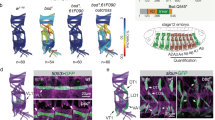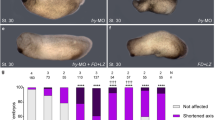Abstract
Cell division in animals must be regulated; during development, for example, proliferation often occurs in spatially and temporally restricted patterns1,2,3, and loss of mitotic control underlies cancer4. The epidermal growth factor receptor (EGFR) has been implicated extensively in the control of cell proliferation in metazoans5,6,7; in addition, hyperactivity of the EGFR and its three relatives, ErbB2–ErbB4, are implicated in many cancers8. But little is known about how these receptor tyrosine kinases regulate the cell cycle. In the developing Drosophila melanogaster imaginal eye disc, there is a single patterned mitosis that sweeps across the eye disc epithelium in the third larval instar9. This 'second mitotic wave' is triggered by EGFR signalling5 and depends on expression of String, the Drosophila homologue of Cdc25 phosphatase, the ultimate regulator of mitosis in all eukaryotic cells10,11,12. Here we show that two antagonistic transcriptional regulators, Pointed, an activator, and Tramtrack69, a repressor, directly regulate the transcription of string. The activity of at least one of these regulators, Pointed, is controlled by EGFR signalling. This establishes a molecular mechanism for how intercellular signalling can control string expression, and thereby cell proliferation.
This is a preview of subscription content, access via your institution
Access options
Subscribe to this journal
Receive 12 print issues and online access
$209.00 per year
only $17.42 per issue
Buy this article
- Purchase on Springer Link
- Instant access to full article PDF
Prices may be subject to local taxes which are calculated during checkout





Similar content being viewed by others
References
Foe, V. E. Development 107, 1–22 (1989).
Zhu, L. & Skoultchi, A. I. Curr. Opin. Genet. Dev. 11, 91–97 (2001).
Dyer, M. A. & Cepko, C. L. Nature Rev. Neurosci. 2, 333–342 (2001).
Corn, P. G. & El-Deiry, W. S. BioEssays 24, 83–90 (2002).
Baker, N. E. & Yu, S. Y. Cell 104, 699–708 (2001).
Schlessinger, J. & Ullrich, A. Neuron 9, 383–391 (1992).
Yu, Q., Geng, Y. & Sicinski, P. Nature 411, 1017–21 (2001).
Yarden, Y. & Sliwkowski, M. X. Nature Rev. Mol. Cell Biol. 2, 127–137 (2001).
Ready, D. F., Hanson, T. E. & Benzer, S. Dev. Biol. 53, 217–240 (1976).
Russell, P. & Nurse, P. Cell 45, 145–153 (1986).
Sadhu, K., Reed, S. I., Richardson, H. & Russell, P. Proc. Natl Acad. Sci. USA 87, 5139–5143 (1990).
Edgar, B. A. & O'Farrell, P. H. Cell 62, 469–480 (1990).
Thomas, B. J., Gunning, D. A., Cho, J. & Zipursky, S. L. Cell 77, 1003–1014 (1994).
Wolff, T. & Ready, D. F. in The development of Drosophila melanogaster Vol. 2 (eds Bate, M. & Martinez-Arias, A.) 1277–1325 (Cold Spring Harbor Laboratory Press, Cold Spring Harbor, NY, 1993).
Lai, Z. C. & Rubin, G. M. Cell 70, 609–620 (1992).
O'Neill, E. M., Rebay, I., Tjian, R. & Rubin, G. M. Cell 78, 137–147 (1994).
Harrison, S. D. & Travers, A. A. EMBO J. 9, 207–216 (1990).
Read, D. & Manley, J. L. EMBO J. 11, 1035–1044 (1992).
Brown, J. L. & Wu, C. Development 117, 45–58 (1993).
Li, S., Li, Y., Carthew, R. W. & Lai, Z. C. Cell 90, 469–478 (1997).
Tang, A. H., Neufeld, T. P., Kwan, E. & Rubin, G. M. Cell 90, 459–467 (1997).
Badenhorst, P. Development 128, 4093–4101 (2001).
Knoblich, J. A. & Lehner, C. F. EMBO J. 12, 65–74 (1993).
Lehner, C. F. & O'Farrell, P. H. Cell 61, 535–547 (1990).
Moreno, S., Hayles, J. & Nurse, P. Cell 58, 361–372 (1989).
Gould, K. L. & Nurse, P. Nature 342, 39–45 (1989).
Lehman, D. A. et al. Development 126, 1793–803 (1999).
Gabay, L. et al. Development 122, 3355–3362 (1996).
Brunner, D. et al. Nature 370, 386–389 (1994).
Badenhorst, P., Finch, J. & Travers, A. Mech. Dev. 117, 87–101 (2002).
Murawsky, C. M. et al. EMBO Rep. 2, 1089–1094 (2001).
Rossi, F. M., Kringstein, A. M., Spicher, A., Guicherit, O. M. & Blau, H. M. Mol. Cell 6, 723–728 (2000).
Xu, T. & Rubin, G. M. Development 117, 1223–1237 (1993).
Lee, T. & Luo, L. Neuron 22, 451–461 (1999).
Lehembre, F. et al. Mol. Cell. Biol. 20, 1072–1082 (2000).
Neufeld, T. P., de la Cruz, A. F., Johnston, L. A. & Edgar, B. A. Cell 93, 1183–1193 (1998).
Kauffman, R. C., Li, S., Gallagher, P. A., Zhang, J. & Carthew, R. W. Genes Dev. 10, 2167–2178 (1996).
Acknowledgements
We thank R. Carthew, M. Domínguez and B. Edgar for reagents; K. Brown for advice on the manuscript; and R. Grenfell for help with FACS analysis. The Developmental Studies Hybridoma Bank (University of Iowa) provided some of the antibodies used. A.B. was supported by an EMBO Fellowship and a Marie Curie Fellowship from the European Union. C.M.M. was supported by the Natural Sciences and Engineering Research Council of Canada, and the Cambridge Commonwealth Trust.
Author information
Authors and Affiliations
Corresponding authors
Ethics declarations
Competing interests
The authors declare no competing financial interests.
Rights and permissions
About this article
Cite this article
Baonza, A., Murawsky, C., Travers, A. et al. Pointed and Tramtrack69 establish an EGFR-dependent transcriptional switch to regulate mitosis. Nat Cell Biol 4, 976–980 (2002). https://doi.org/10.1038/ncb887
Received:
Revised:
Accepted:
Published:
Issue Date:
DOI: https://doi.org/10.1038/ncb887
This article is cited by
-
Integrative genomic analyses reveal putative cell type-specific targets of the Drosophila ets transcription factor Pointed
BMC Genomics (2024)
-
Regulatory mechanisms of EGFR signalling during Drosophila eye development
Cellular and Molecular Life Sciences (2016)
-
Src kinase function controls progenitor cell pools during regeneration and tumor onset in the Drosophila intestine
Oncogene (2015)
-
Drosophila Myc integrates multiple signaling pathways to regulate intestinal stem cell proliferation during midgut regeneration
Cell Research (2013)
-
Molecular mechanisms of EGF signaling-dependent regulation of pipe, a gene crucial for dorsoventral axis formation in Drosophila
Development Genes and Evolution (2012)



